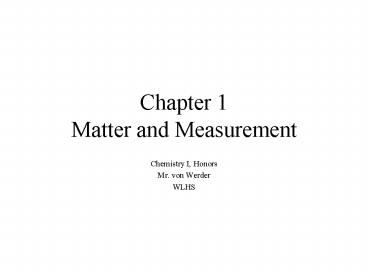Chapter 1 Matter and Measurement - PowerPoint PPT Presentation
1 / 20
Title:
Chapter 1 Matter and Measurement
Description:
Chapter 1 Matter and Measurement Chemistry I, Honors Mr. von Werder WLHS Matter flowchart Classification of Matter A Few Methods of Separation Filtration Distillation ... – PowerPoint PPT presentation
Number of Views:127
Avg rating:3.0/5.0
Title: Chapter 1 Matter and Measurement
1
Chapter 1Matter and Measurement
- Chemistry I, Honors
- Mr. von Werder
- WLHS
2
Matter flowchart
3
Classification of Matter
4
A Few Methods of Separation
- Filtration
- Distillation
- Chromatography
- Paper
- Gas
5
Filtration
- Separates solid substances from liquids and
solutions.
6
Distillation
- Separates homogeneous mixture on the basis of
differences in boiling point.
7
Chromatography
- Separates substances on the basis of differences
in solubility in a solvent.
8
Gas Chromatography
9
SI Units
- Système International dUnités
- Uses a different base unit for each quantity
10
Metric System
- Prefixes convert the base units into units that
are appropriate for the item being measured.
11
Volume
- The most commonly used metric units for volume
are the liter (L) and the milliliter (mL). - A liter is a cube 1 dm long on each side.
- A milliliter is a cube 1 cm long on each side.
12
Uncertainty in Measurements
- Different measuring devices have different uses
and different degrees of accuracy.
13
Temperature
- A measure of the average kinetic energy of the
particles in a sample.
14
Temperature
- In scientific measurements, the Celsius and
Kelvin scales are most often used. - The Celsius scale is based on the properties of
water. - 0?C is the freezing point of water.
- 100?C is the boiling point of water.
15
Temperature
- The Fahrenheit scale is not used in scientific
measurements. - ?F 9/5(?C) 32
- ?C 5/9(?F - 32)
- The Kelvin is the SI unit of temperature.
- There are no negative Kelvin temperatures.
- K ?C 273.15
16
Density
- Physical property of a substance
17
Significant Figures
- The term significant figures refers to digits
that were measured. - When rounding calculated numbers, we pay
attention to significant figures so we do not
overstate the accuracy of our answers.
18
Significant Figures
- All nonzero digits are significant.
- Zeroes between two significant figures are
themselves significant. - Zeroes at the beginning of a number are never
significant. - Zeroes at the end of a number are significant if
a decimal point is written in the number.
19
Significant Figures
- When addition or subtraction is performed,
answers are rounded to the least significant
decimal place. - When multiplication or division is performed,
answers are rounded to the number of digits that
corresponds to the least number of significant
figures in any of the numbers used in the
calculation.
20
Accuracy versus Precision
- Accuracy refers to the proximity of a
measurement to the true value of a quantity. - Precision refers to the proximity of several
measurements to each other.































